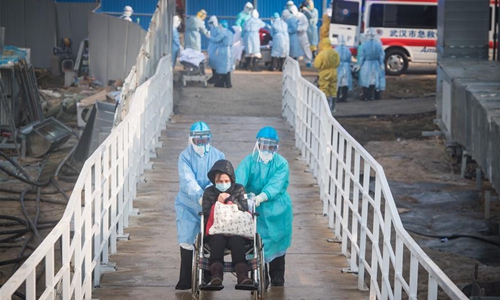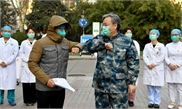Coronavirus epicenter faces severe test as actual number of infections still unknown

Medical workers help the first batch of patients infected with the novel coronavirus move into their isolation wards at Huoshenshan (Fire God Mountain) Hospital in Wuhan, central China's Hubei Province, Feb. 4, 2020. (Xinhua/Xiao Yijiu)
Wuhan, the epicenter of the deadly coronavirus in Central China's Hubei Province, still faces a severe test after nearly two weeks of being in lockdown, as a large number of patients have not received timely treatment, causing more pressure and no turning point is in sight yet, officials and experts said.
Hubei has reported 19,665 confirmed coronavirus cases as of Thursday, of which 10,117 are reported in Wuhan, the capital city of the province, according to the local health commission. That number accounts for more than 50 percent of the total number of confirmed cases in the province, which is also the highest nationwide.
Local authorities in Wuhan said there are 20,629 people in quarantine at home. All the districts in the city are required to finish nucleic acid tests on all suspected cases in order to make sure patients can be treated as soon as possible.
Those are highly challenging requests for Wuhan, according to media reports.
The numbers of confirmed cases in Wuhan keep growing every day, which does not, however, reflect the whole picture as analysts do not know the exact number of infections. Medical supplies could not meet the rising demand for treatment, heavily weighing on the battle against the spread of the disease.
Currently, there are 28 novel coronavirus-designated hospitals with 8,524 beds in Wuhan. A total of 8,182 patients are in these hospitals, Hu Lishan, deputy Party secretary of Wuhan, said during a press conference.
"To be honest, we did not do well enough in some areas and we need to do better," Hu said.
He noted that there were only 421 beds available in these hospitals on Tuesday so many confirmed or suspected patients could not get a bed in a designated hospital, which Hu said is very heartrending and painful.
To treat as many patients as possible, Wuhan has built "Fang Cang" shelter hospitals, converted from Hongshan Gymnasium and Wuhan International Conference and Exhibition Center, as well as a cultural building complex dubbed "Wuhan Living room" as quarantine centers to treat patients suffering from mild symptoms of infection.
These hospitals have been gradually put into use starting from Wednesday night.
Besides those, local authorities have been turning more places, including hotels and schools, into areas for quarantine. As of Tuesday, 132 quarantine points have been established across the city, offering 12,571 beds to put more suspected patients into quarantine, Hu noted.
A total of 2,000 medical personnel from 20 provinces have arrived in Wuhan to serve the three hospitals, he said.
People have been classified into different areas according to their symptoms like suspected patients and patients with fever. Their daily demands for medical and living materials are ensured, he said.
Also, local authorities required all designated hospitals in Wuhan to only treat patients in severe and critical conditions, and those suspected of being in critical condition, urging them to enhance treatment and lower death rates.
Wang Chen, vice president of the Chinese Academy of Engineering and an expert on respiratory and critical medicine, said in an interview with a state broadcaster on Wednesday night that it is still too early to predict the inflection point of the epidemic as Wuhan still faces a severe situation, and actual numbers of infections are still unknown.
Many people could not be treated in a timely manner, and those who are in quarantine at home can cause further infections in families and communities, Wang said.



